17+ Latest UX Statistics You Need To Know In 2024
User experience (UX) is an important part of website design. This is even truer for businesses that cater to both desktop and mobile users.
Having great design and functionality is a combination that will help you land more sales.
In this UX statistics roundup, we’ll show you just how valuable it is and what the trends brands and marketers are following to keep customers satisfied.
You can use these insights to improve your own website and mobile apps to give your website visitors a reason to continue supporting your brand.
Here are the latest UX statistics that you need to know.
Editor’s picks
- 88% of consumers are less likely to return to a site with bad UX. (HubSpot)
- 45% of users expect content to display correctly across different devices. (Adobe via Slideshare)
- Voice technology is changing the user experience. (Forbes)
UX adoption statistics
First, let’s take a closer look at how both consumers and businesses view the importance of a great user experience.
How does user experience impact ecommerce sites and apps? How are businesses adjusting? And do everyday users really care about mobile optimization? What do these user experience statistics say about company websites?
We’ll talk about these and more in this section.
88% of consumers are less likely to return to a site with bad UX.
Out of all these user experience statistics, this one is the most important.
According to a report, 88% of online consumers are less likely to return to a site after a bad experience.
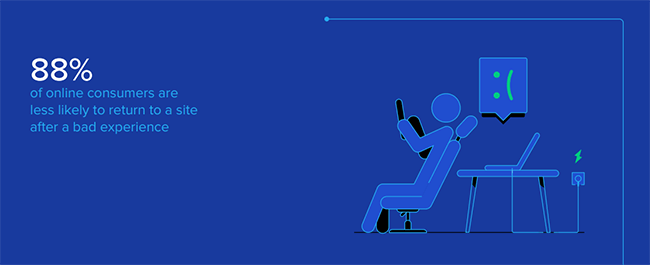
This problem isn’t limited to websites though. Apps with bad UX will also experience the same drop in users. 90% of consumers reported that they stopped using an app because it performed poorly.
Retailers will want to improve their user experience because of this. The same source says that slow-loading websites cost them $2 billion in lost sales each year. 53% of mobile users abandon their visit if the site takes more than 3 seconds to load.
Source: Hubspot
Consumers are more likely to share a negative UX experience with others.
A not-so-surprising user experience statistic is sharing negative experiences, in-person and online.
46.7% of consumers that had a negative user experience or customer experience (CX) said they’d tell their friends about their bad shopping experience through email, phone, or in person. Only 44% said they’d do the same if they had a great time.
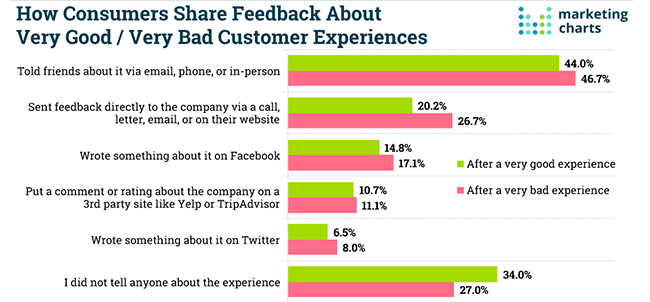
Others are also more likely to share their negative experience through other platforms such as Facebook, Twitter, and TripAdvisor.
Source: Marketing Charts
Note: Issues with shopping carts are another reason customers may share their negative experiences. To learn more, check out our post on shopping cart abandonment statistics.
75% of consumers judge a site’s credibility based on how it looks.
75% of site visitors will decide if a site is credible based on its overall aesthetics. That means if consumers find the site’s user experience to be bad, they’ll likely back out and look for other options. What’s even more terrifying is that this decision can be made in just 3.42 seconds.
So if you want people to stay and shop on your site, your user experience should impress them right away.
Source: Pop Web Design
32% of users will leave a brand they love if they have one bad experience.
Even if you develop a great following and have loyal customers, bad UX can still ruin your business. 32% of surveyed consumers said that they’ll willingly abandon a brand that they love if they so much as have one bad experience.
That percentage is even higher for consumers in Latin America. There, 49% said that they’d walk away from a brand under the same circumstances.
Source: PWC
45% of users expect content to display correctly across different devices.
Out of all these user experience statistics, this one always seems to catch business out – the importance of mobile responsiveness.
Mobile users are on the rise and consumers have high expectations these days when it comes to mobile responsiveness. 45% of users expect a site to load properly regardless of the device used to access the page. And should they encounter a site that’s not working on their device, they’re five times more likely to drop whatever they’re doing and move on to something else.
If your site isn’t optimized for mobile devices, you should take the appropriate measures so that you don’t lose potential customers.
Source: Adobe via Slideshare
A user will settle on a key area of a page in 2.6 seconds.
It only takes 2.6 seconds for a user to settle on a key area of your site. What does that mean for you? It means you have that much time to impress your site visitors. If their eyes can’t find something to land on during that time, your chances of losing them grow higher.
Make sure that page elements such as your menu, text, and images are capable of grabbing a user’s attention.
Source: CXL
Business-related UX statistics and trends
Poor user experience does have an impact on online shoppers. That’s why businesses should learn how to perform user experience testing. Having a great website can be a competitive differentiator. It could set you apart from every other ecommerce site in your niche.
Website owners are hiring web designers to improve their online presence. Even small business websites are aware of how poor user experience can ruin their reputation.
If you’re still on the fence about hiring a user experience designer, here are a few user experience stats that might convince you to pull the trigger.
Brands must learn to marry UX and CX.
User experience and customer experience (CX) are two separate ideas. While a user might find it easy to navigate through your platform, they can still walk away disappointed if you aren’t able to nail CX.
A Forbes article by UserZoom Co-CEO Alfonso de la Nuez explains the difference between the two. He uses his real-life experience of ordering pizza. While he found the food delivery app he used to be great, it all fell apart when the delivery took way too long. And to add insult to injury, the pizza place got his order wrong.
The great user experience he felt while ordering was ruined by the terrible experience he had afterward. Brands need to find a way to improve their UX and CX simultaneously.
Source: Forbes
Every dollar spent on improving UX will return $10 to $100.
According to UX Planet, the general rule of thumb is that every dollar spent on improving UX/UI will return $10 to $100 — that is if the organization will willingly focus on routinely improving their user experience. This is especially true for SaaS companies.
The source further adds that having a focus on design will help your bottom line by making a positive impact on other business metrics such as customer retention, customer loyalty, and user productivity.
Source: UX Planet
45.9% of businesses will prioritize customer experience in the next 5 years.
45.9% of businesses said that they will focus on improving their customer experience in the next five years. 20.5% said they’ll focus on pricing while 33.6% said they’’ prioritize working on their products.
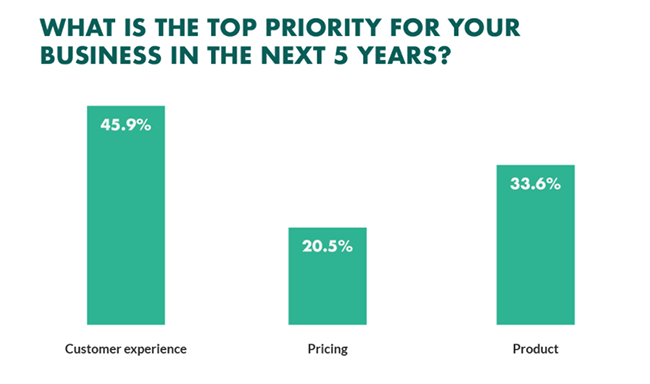
This only proves that entrepreneurs and marketers are more receptive now to improving UX and CX.
Sales-related UX statistics and trends
Having great desktop and mobile UX will bring in more sales to your business. But you don’t have to take our word for it. There are web design statistics that’ll tell you that this really is the case for most internet users.
If you want to generate more revenue, you should make sure that your site is mobile-friendly, have a good loading time, and conceptualize a fantastic UX design layout. You don’t want to frustrate your existing customers with a bad user interface.
Businesses lose 35% of sales due to bad UX.
According to a study by Amazon Web Services, ecommerce businesses leave 35% of sales on the table due to bad user experience. This translates to roughly $1.4 trillion worth of sales.
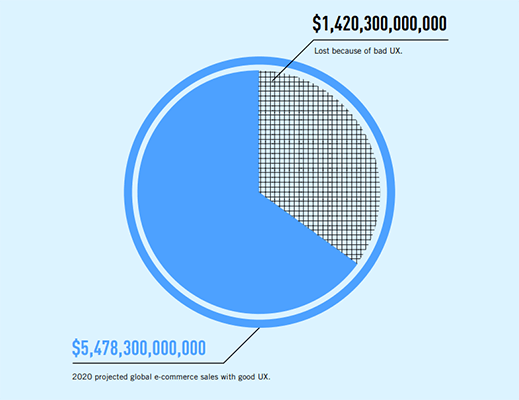
On the other end of the spectrum, businesses that have good UX were projected to reach global ecommerce sales of at least $5.4 trillion in 2020.
Source: Amazon Web Services
A 0.1-second site speed improvement leads to better sales.
According to the Milliseconds Make Million report, a 0.1-second site improvement led to a lot of improvements in sales. For instance, improving the site speed led to an 8.4% increase in conversions with retail consumers. There was also a 9.2% increase in average order value.
This also affected other improvements in page views, conversion rates, and average order value.
There were also industry-specific improvements as well. In luxury sites, there was an 8% increase in page views. And there was a 10.1% increase in conversions for those in the travel industry.
Source: Deloitte – Milliseconds Make Millions Report
Technology-related UX statistics and trends
UX designers are now taking into account what user research stats have to say about the future of commerce websites. Technology will have a huge impact on what a web designer must incorporate to keep user engagement numbers as high as they can be.
Below are just a few user experience stats on how technology will affect UX in the years to come.
Voice technology is changing the user experience.
Voice technologies are changing the way users interact with ecommerce sites. That’s why there’s a broader boost in the adoption of voice and speech recognition among companies. They are, after all, becoming more accessible and widely available.
Some examples of the way voice technologies are changing ecommerce include virtual assistants, voice-enabled chatbots, and fraud detection.
Source: Forbes
Video is becoming a priority for marketers.
To improve user experience, many marketers are now shifting their focus to video content. Its usage and spend increased slightly in 2020 and plans are already in place to increase these further in 2021.
But while videos are seen as a necessity by marketers and consumers during the height of Covid-19, the pandemic’s impact on businesses affected their budget which resulted in shelving plans for more content.
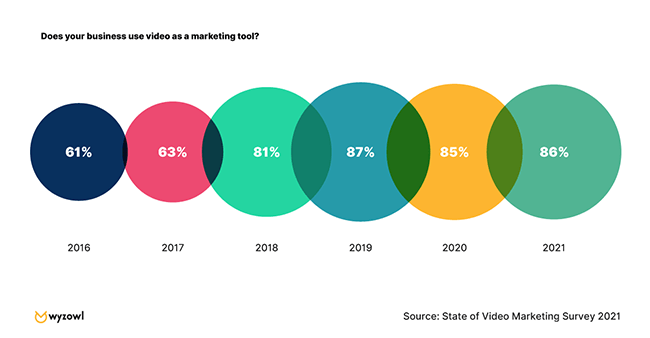
As of 2021, 86% of businesses use videos as a marketing tool which is 1% higher than 2020’s figure.
Source: Qyzowl via Hubspot
UX statistics sources
Final thoughts
And that wraps up our collection of the latest user experience statistics. Now you know just how important user experience is for both your desktop and mobile users.
Use these ux stats to improve your website’s conversion rate, and avoid the problems of poor ux by making sure your website and mobile apps are user friendly.
Remember: flashy design doesn’t make up for bad UX design. With a strong focus on UX design, your website visitors will be kept happy and your website’s conversion rates will increase as well. Everybody wins.
Looking for more statistics? Be sure to check out these roundups:
